Nab a glimpse into the mysterious interpretation of 'Hounds of Hell' in biblical texts, and unravel the intriguing truths that lie beneath.
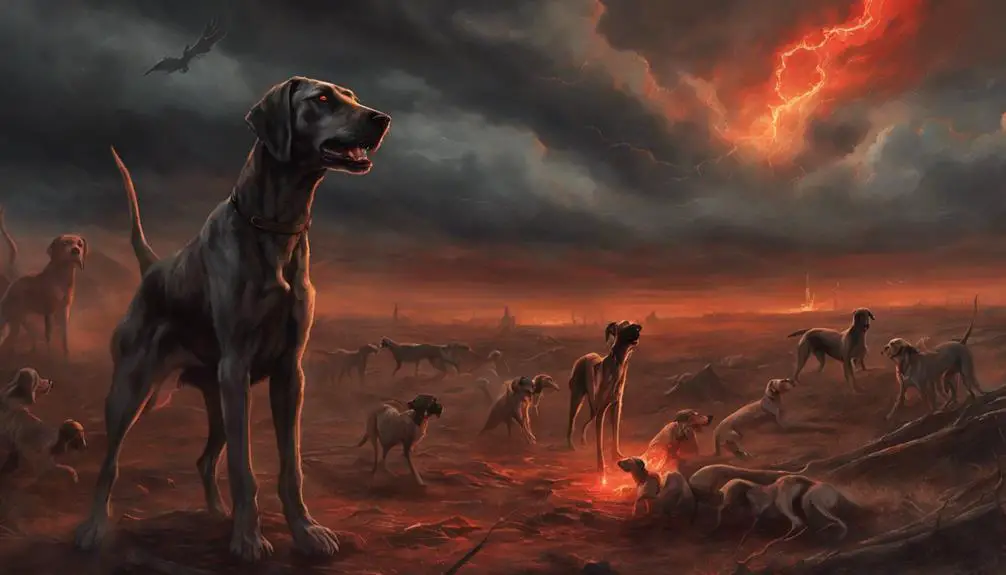
Hounds of Hell in the Bible
Like a hound on a scent, you've probably come across the term 'Hounds of Hell' in various forms of literature and pop culture. However, you might be surprised to learn that these infernal creatures have roots in biblical texts.
The Bible, with its vast and intricate tapestry of tales and symbols, has frequently been interpreted as containing references to such entities. Yet, is this truly what the original authors intended, or is it a product of later interpretations and translations?
Let's embark on this exploration together, and you might find your perspective on this topic utterly transformed.
Key Takeaways
- Hellhounds, symbolizing death and doom, have deep roots in ancient mythologies and religious beliefs, including the Bible.
- Biblical creatures like Leviathan and the Dragon share hellish characteristics akin to hellhounds, representing fear and divine judgment.
- Dogs in the Bible often symbolize divine intervention and impending doom, similar to the hellhound's role in Christian mythology.
- Misconceptions exist about hellhounds, viewing them as the Devil's pets or bad omens, despite potential interpretations as divine guardians.
Origins of the Hellhound Concept
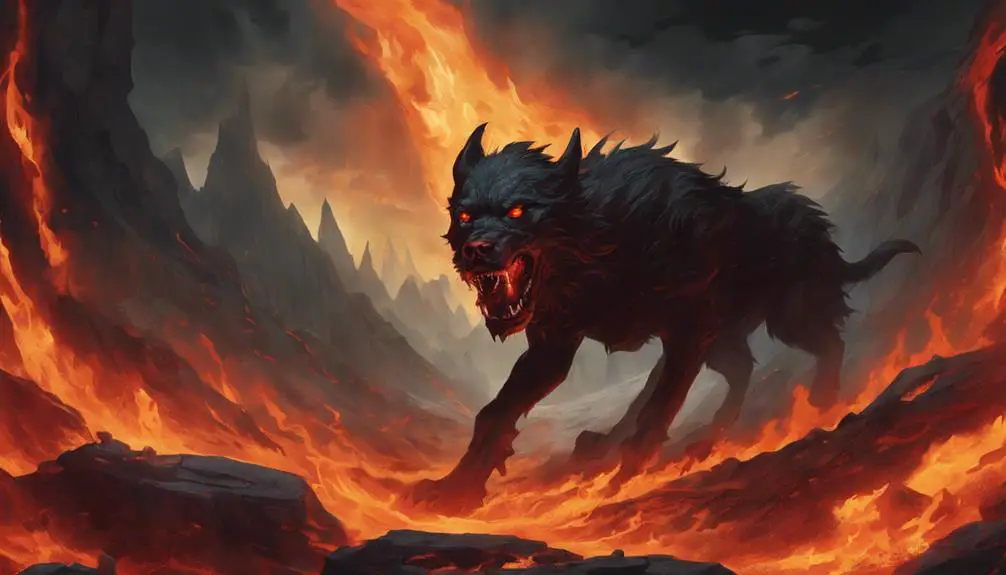
The concept of the Hellhound, often depicted as a demonic dog of the underworld, has its roots deeply embedded in ancient mythologies and religious beliefs. You'll find that this supernatural entity isn't exclusive to a single culture or religion. Instead, it has been embraced and adapted by various civilizations over centuries, each contributing to the evolution of its depiction.
This Hellhound depiction has always been associated with death, the afterlife, and often served as an omen of doom. In Greek mythology, for instance, Cerberus, the three-headed dog, guarded the gates of Hades, preventing the dead from escaping. Similarly, in Nordic folklore, the Garmr was a blood-stained hound stationed at Hel's gate, the Norse goddess of death.
In both cases, these supernatural entities aren't merely watchdogs but symbols of a boundary between life and death, the mortal world and the underworld. They embody the fears and mysteries associated with death and the afterlife, serving as a tangible representation of the unknown. It's clear that the Hellhound's prevalent depiction in these ancient mythologies has significantly influenced its portrayal in later cultures and religious beliefs.
Biblical References With Hellish Creatures
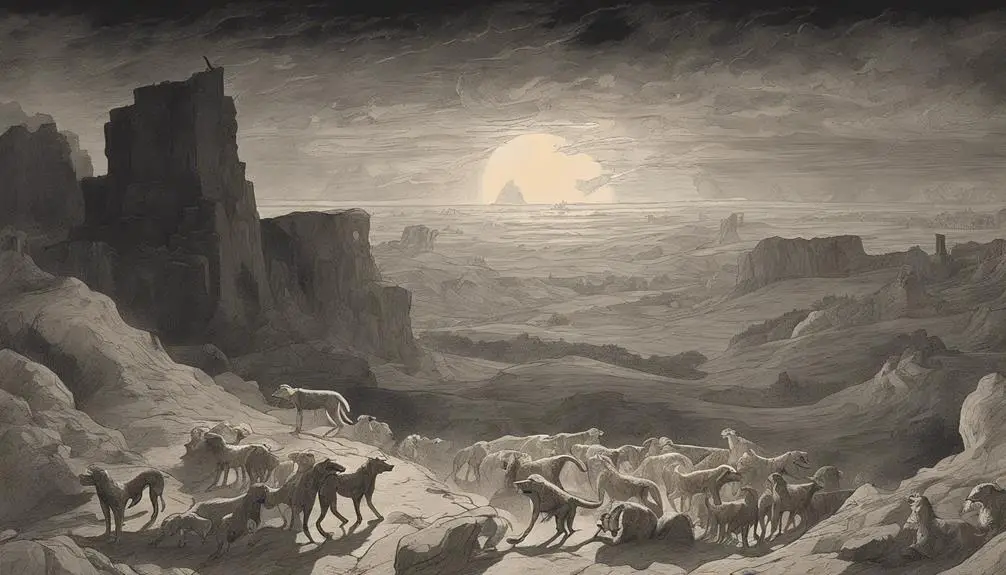
Diving into biblical texts, you'll uncover several references to creatures bearing hellish characteristics, often symbolizing evil, sin, or punishment. The Bible introduces various terrifying beasts that can be viewed as parallel constructs to the concept of demonic canines.
- The Leviathan: In the Book of Job, the Leviathan is described as a fearsome sea serpent, a creature of nightmares. Its breath sets coals ablaze, and flames dart from its mouth. This beast's depiction resonates with the fiery attributes often associated with hellish creatures.
- The Behemoth: Another creature from Job, the Behemoth is an enormous, powerful beast. Its strength in its loins, and its force in the muscles of its belly, paints a picture of a creature of formidable might, reminiscent of the strength attributed to demonic canines.
- The Dragon: Revelations refers to Satan as a red dragon with seven heads, an image that evokes terror and hellish connotations.
- The Beast: Also from Revelations, the Beast is a creature with seven heads and ten horns, representing kingdoms and kings, symbolizing corruption, and evil, themes often associated with hell and its inhabitants.
These biblical beasts give us insights into the terrifying imagery that has influenced the concept of demonic canines.
Symbolism of Hounds in the Bible
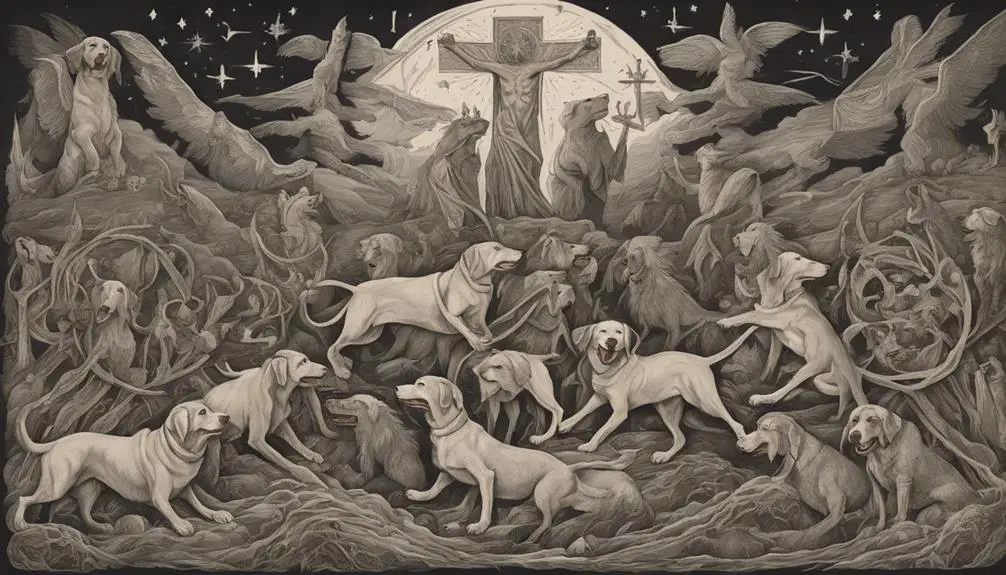
When you delve into the symbolism of hounds in the Bible, you'll find that they often represent both divine intervention and impending doom. Canine metaphors aren't uncommon in biblical texts, serving as potent symbols of divine messages or forewarnings of dire events.
Consider the role of dogs in the Old Testament. They're seen as scavengers, often associated with disgrace and degradation. However, this isn't a simple, one-dimensional portrayal. The Bible uses these canine metaphors to communicate spiritual truths. The scavenging dogs, for example, are a stark reminder of the consequence of spiritual disobedience.
Moving to the New Testament, the symbolism takes a different turn. Here hounds, or dogs, are sometimes used to represent those outside of the faith, highlighting the divide between believers and non-believers.
These biblical beasts, in their various roles, embody the dichotomy of divine intervention and impending doom. They serve as a reminder of divine judgment, but also of the opportunity for redemption. It's this balance that makes the symbolism of hounds in the Bible so compelling. They are, in essence, divine messengers wrapped in canine metaphors, filled with warnings and promises alike.
Hounds of Hell in Christian Mythology
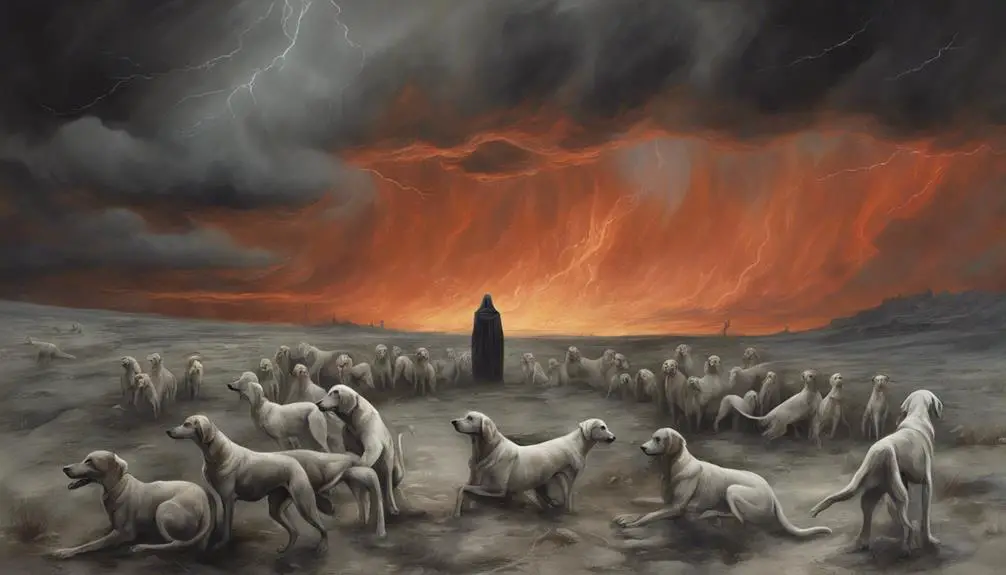
In Christian mythology, you'll encounter the chilling concept of the 'Hounds of Hell', spectral entities believed to hunt the souls of the damned. These ethereal canines are seen as potent representations of death and the afterlife. Their depiction is deeply embedded in the collective consciousness, symbolizing the relentless pursuit of sinners.
Hellhound representation in Christian mythology aims to convey a number of symbolic meanings:
- Punishment: The hounds are often perceived as the executors of divine punishment, relentlessly pursuing those who've strayed from righteousness.
- Fear: Their fearsome appearance and relentless pursuit embody the fears associated with death and the unknown.
- Moral Guidance: The hounds serve as an ominous warning, reminding individuals of the dire consequences of immorality and sin.
- Redemption: Despite their fearsome reputation, the hounds' pursuit of wrongdoers hints at the possibility of redemption and divine mercy.
The hounds of hell, with their unique Christian symbolism, continue to be a powerful image in understanding the complex ideas of sin, punishment, and redemption in Christian mythology.
Interpretations and Misconceptions
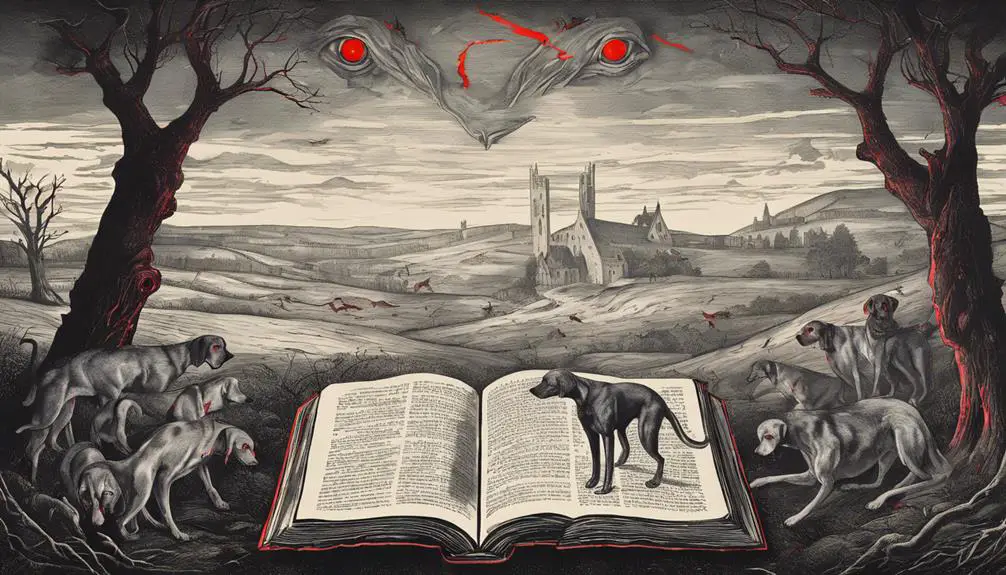
As we examine the hounds of hell further, you'll find that various interpretations and a handful of misconceptions have emerged over time, clouding our understanding of these spectral canines. The Hellhound's representation is often misconstrued, with many viewing these creatures solely as the Devil's canines, agents of death, or omens of misfortune.
However, a detailed examination of biblical texts reveals a more nuanced understanding. Some scholars argue that hellhounds could also serve as divine guardians of the spiritual realm, protecting the sacred from the profane. This interpretation contradicts the common misconception of hellhounds as purely evil entities.
Another misconception is the belief that hellhounds are always associated with the Devil. The term 'Devil's canine' is misleading as it implies a direct association with the Devil. However, in biblical texts, hellhounds are typically associated with the underworld or afterlife, not specifically with Satan.
These misconceptions and varied interpretations underline the importance of examining biblical texts closely. They remind us that our understanding of such creatures as the hellhounds is often influenced by cultural interpretations and personal beliefs, which can sometimes cloud the true biblical representation.
Impact on Popular Culture and Literature
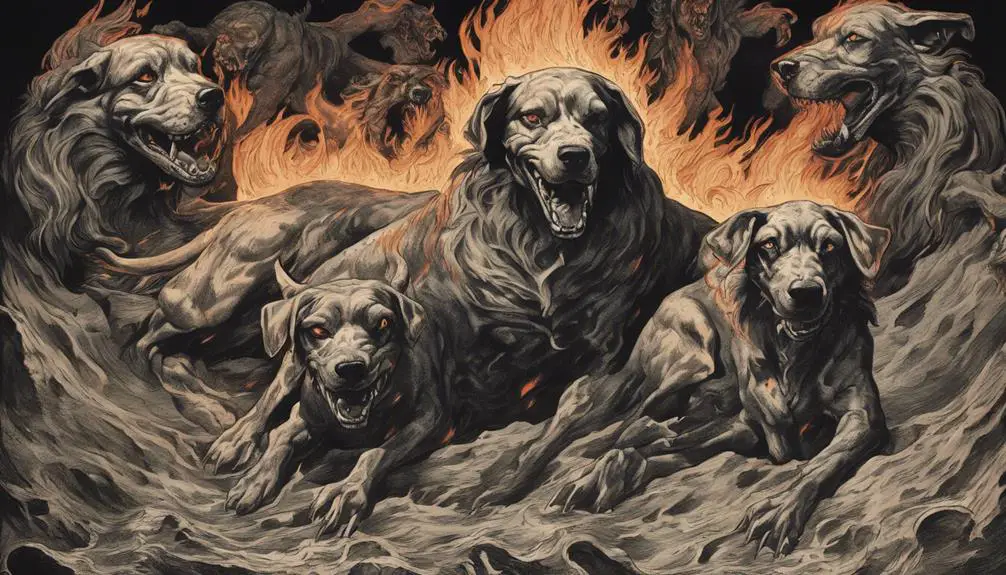
Countless works of popular culture and literature have been significantly influenced by the biblical concept of hellhounds, underscoring their enduring relevance and fascination. The Hellhound Influence seeps into various mediums, shaping cultural depictions with its menacing presence.
- In literature, hellhounds often serve as ominous symbols of impending doom. Their fearsome image, drawn from biblical descriptions, adds depth to narratives, intensifying the sense of danger and dread.
- Music also bears the mark of the hellhound's influence. Blues legend Robert Johnson's song 'Hellhound on my Trail' is a testament to this. The song's chilling lyrics metaphorically use the hellhound to represent personal demons and inescapable guilt.
- In the realm of cinema and television, hellhounds often personify evil forces. From the terrifying creature in 'The Omen' to the spectral dogs in the 'Harry Potter' series, their portrayals consistently echo biblical narratives.
- Even in video games, hellhounds make their mark. Games like 'Diablo' and 'World of Warcraft' feature hellhounds as formidable adversaries, reinforcing their image as fearsome, supernatural beings.
The cultural depictions of hellhounds, regardless of the medium, are testament to their pervasive influence and the enduring fascination they hold in our collective psyche. These depictions continue to shape our understanding and interpretation of these biblical beasts.
Frequently Asked Questions
What Are Some Other Cultures That Have Similar Concepts to the Hellhound?"
You'll find hellhound symbolism isn't unique to just one culture. Similar concepts exist worldwide.
For example, in Greek mythology, Cerberus is a three-headed dog guarding the underworld. The Black Shuck of English folklore is another example.
In Norse mythology, you have Garmr, a dog associated with Ragnarök. Each culture uses the hellhound to symbolize death, the afterlife, or something foreboding, making it a fascinating point of cultural comparison.
How Has the Depiction of Hellhounds Evolved Over Time?"
You've noticed that Hellhound symbolism and Hellhound origins have evolved over time. Initially, they were viewed as ominous omens of death, but today, they're often depicted as loyal protectors in fantasy literature and pop culture.
This shift reflects our society's changing attitudes towards death and the afterlife. However, it's important to remember that these contemporary depictions don't necessarily align with traditional folklore or religious texts.
Are There Any Specific Biblical Passages That Directly Mention Hounds of Hell?"
You're asking if there are biblical passages that mention hellhounds. Interestingly, there aren't any.
The Bible doesn't directly reference 'hounds of hell.' Hellhound symbolism and biblical interpretations often overlap, but they're drawn from different mythologies and religious traditions.
The concept of hellhounds is more prevalent in folklore and mythology than in biblical scripture. So, no, you won't find specific mentions of hellhounds in the Bible.
Are There Any Prominent Figures in Christian Mythology Associated With Hellhounds?"
In Christian mythology, there aren't any figures directly associated with hellhounds. However, you'll find hellhound symbolism prevalent in various forms of literature and art, often drawing on the Greek myth of Cerberus.
Cerberus depictions, while not from Christian texts, have permeated into Christian-influenced areas, suggesting a shared cultural fear of menacing, underworld guardians. These representations, however, are extrapolations and not biblically based.
What Are Some Modern Interpretations of the Hellhound in Current Religious Practices?"
You'll find modern interpretations of the hellhound in various religious practices. Hellhound symbolism often represents death, the underworld, or something evil.
In some modern superstitions, they're seen as omens of death or disaster. While this interpretation may differ from traditional religious texts, it's a common theme in pop culture.
The hellhound's role as a supernatural creature of the night continues to captivate and terrify in equal measure.
Conclusion
So, you've journeyed through the murky realms of hellhounds in the Bible, dissecting their origins, symbolism, and impact on popular culture.
It's clear that these spectral canines play a more complex role in biblical and Christian mythology than just mere beasts of Hell.
Misinterpretations abound, but understanding their true significance helps us appreciate the richness of biblical narratives and their enduring influence on our cultural imagination.



Sign up